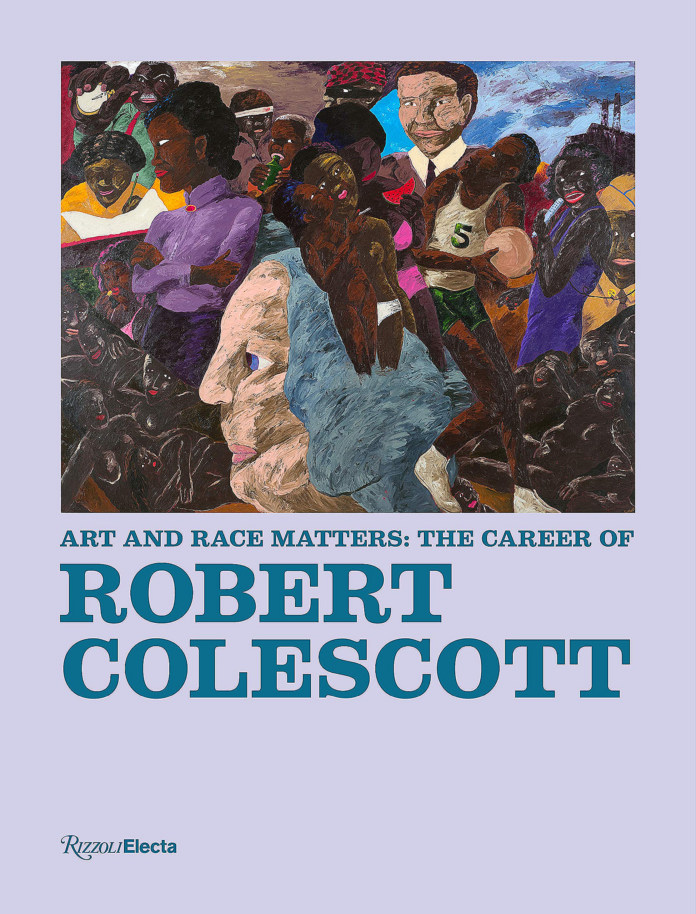After reading Art and Race Matters: The Career of Robert Colescott by Raphaela Platow (Editor), Lowery Stokes Sims (Editor) and companion to a major traveling retrospective art exhibition, when I found both the life story of this now-deceased Black artist, and his prolific canvas magic, to be derogatory and insulting both to Blacks, and to women? A painter, distinguished art professor and mentor, whom, might I add, I had never heard of.
Colescott, with his colorful satirical paintings, poked fun at American stereotypes against Blacks, and confronted sex, gender, and other issues head-on. That so many contemporary Black artists including Kara Walker, Kehinde Wiley, Kerry James Marshall, and Henry Taylor claim Colescott as a major source of inspiration, made me take notice. Here was a guy who admired the comic social commentary of Dick Gregory and Richard Pryor. These ideas made me want to meet this man, who now lives up in heaven with God, laughing at my ignorance while balancing his palette.
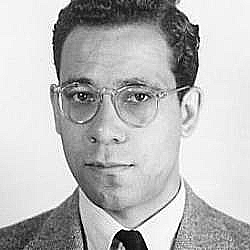
Last month, after a year of thinking and talking about this artist, I felt it time to delve back into this perplexing work, treating it like I was back in graduate school. And what did I discover? That just touching the surface does not reveal the deeper meaning, which can be many-layered, in art, and in life. And, as they say, life informs art. Art, and life, affect people in diverging ways. For Colescott’s life story is truly a tale that could only happen in the United States of America.
Here, in this book, we find an intelligent, gifted master of painting who was also loving and kind, according to the testimonies. As a youngster in 1930s Oakland, California, although fair-skinned with curly hair, Colescott knew that he was Black. But his determined and domineering transplanted New Orleans Black Creole mother, who, like most parents, wanted the best for her children, insisted that the family “pass for white” in Oakland, to take advantage of privileges that were then denied to Blacks. Thus, Colescott, who, like his father, was against the idea, acquiesced. At turns, this painter was either “passing,” or being “racially ambiguous,” during his first 43 years on the planet.
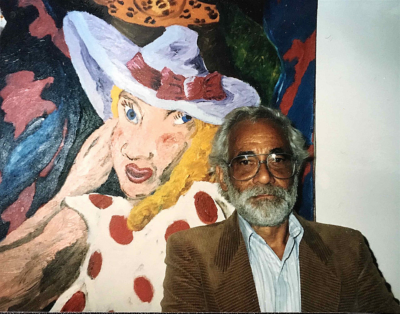
To his credit, Colescott did abandon his share of the “family falsehood,” and became a Black man after studying in Egypt in the 1960s, during the American Civil Rights era. Colescott’s decision to live the second half of his life as the race “God made him,” was at a cruel cost. His older brother Warrington Colescott, also an artist, and with whom he was very close, never forgave him, and broke contact, as Warrington chose to “stay white.” In Wikipedia, you will find Robert listed as “Black” and Warrington as “Creole.” Two brothers, same parents, but claiming different races.
So, Colescott knew “both sides of the street.” As a white, then a Black man, Colescott married four white women in succession. Here was a man whom it is said, “had women troubles.”

Colescott’s obsession with white women is clear in the art in this book, which is heavily seasoned with white nudes, but with a purpose, that includes, as one writer points out, to help Colescott reconcile with his life choices. In his senior years, Colescott began a decade-long relationship with a Black woman, whom he took to the altar when he was a tender 81, two years before his 2009 transition.
As a proud Black woman, I found Colescott’s white woman orientation unsettling, making him and his art harder to process. I am one of those Black ladies who only dates “inside her race,” though I did have a short fling with an older Puerto Rican man with a definite “lick of the tar brush,” as my paternal aunt would exclaim. I relate better to and prefer dating Black men, and resent that there are some Black men don’t feel the same about us Black women, based on the many interracial couples I see in my Brooklyn, NY neighborhood, and most of the Black stars. I guess, to arrive, is to have a blonde at your side, for these men.
“What am I, just chopped liver?” That’s how it feels sometimes.
If Colescott were still alive, and I dared, I would confront the man with voyeur-type questions. How did it feel to have lived as white, then Black? What type of person were you, as a white man? What did you say, as a white/black child, when you heard your white friends mouth racial slurs and beat up Black kids? Did you join in?
Regarding Colescott’s paintings, why did he often depict the Black woman as a mammy, strong, but matronly and unattractive, with sambo bright red lips, but the white female as a beautiful blonde, thus a winner in the game of romance? Why was Colescott obsessed with sex? That most men are, is not a good answer. Who, besides the wonderful singer Harry Belafonte, can be a “Soul Brother,” yet court, marry, and, in Colescott’s case, impregnate, white women? Did Colescott not find Black women attractive? Why marry a Black woman two years before death? Was that a symbolic gesture?
As you can see, this could easily be two articles, with the intertwining curious life story and art created to shock you, then make you think.
Art and Race Matters: The Career of Robert Colescott published by Rizzoli Electa is a masterpiece art book that captures together vivid matte reproductions of Colescott’s pieces, and detailed commentary about the artist, his life, and his work. The actual exhibit is currently on display at the Portland Art Museum. Unfortunately, due to COVID-19, the museum is closed, so the only soul who can enjoy what must be a feast for the eyes, is the occasional museum mouse.
P.S. The museum says that it has enlarged the Colescott exhibitions’ presence on its website. There were six Colescott paintings present.
Colescott’s art is truly the story of America since the arrival of enslaved Africans over 500 years ago. And, regrettably, the racism portrayed on Colescott’s canvas still exists in our country, which is why, argue the scholars, artists, and writers who penned this tome, Colescott is even more relevant today. Colescott deals with the issues of race, including interracial coupling, gender, sex, and persistent, ugly stereotypes which have been used to abuse and dehumanize groups of people. The artist’s work, done on large canvases using acrylic paint, with a magenta underpainting, is not for the faint of heart. Think before you peek if you are troubled by artistic renderings of sex themes. Luckily for those folks, none of the racy sex-inspired paintings accompany this review.
Art and Race Matters, with its lovely though graphic cartoon-style paintings, may shock and disturb the viewer. Our reader must then absorb the commentary, and come to understand what Colescott is telling us, with his “many layers of meaning.”
Below are examples of this great man’s art. By the way, if you fall in love with and desire to acquire any of Colescott’s original works, better walk with upwards of $500,000 when headed to the art gallery. That estimate is based on what several of his pieces have sold for, based on a recent Google search. My hope is that during his lifetime, Colescott was compensated at the rates his paintings now fetch. I suspect not.
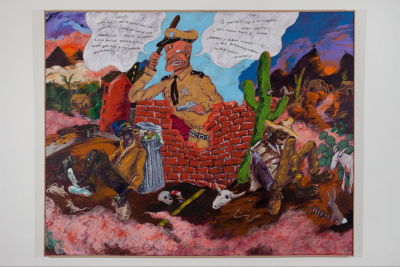
The Bilingual Cop (1995)
A white policeman barges over a brick wall, the other side of which lean two sleeping males of color, a brown-skinned Mexican sporting a sombrero, and an American Black. Both men have passed out, each still clutching the bottle whose contents inebriated them. The cop barks angry, demeaning, stereotypical racial slurs at the Black man in English, and the Mexican, in Spanish. Why is that menacing policeman wielding a raised nightstick and a pointed pistol, confronting two sleeping men who in their drunken state are virtually unconscious? Does the cop somehow feel he is in danger? How? Or has he, and other racist white policemen, become what writers in the 1960s termed “The new Ku Klux Klan,” who kill Blacks first, and ask questions later? Why is this “man of the law” so angry at these two alcoholics of color, seeking to further humiliate and dehumanize them?
Ever notice that many ethnic groups that have been abused by “whites” seem to have turned to booze and drugs for solace? Blacks, Native Americans, some Hispanic peoples, Aborigines’, Afro-Brazilians, the Irish? Food for thought.
Surprising that I can relate to negative portrayals of cops, being an offspring of a highly decorated, now deceased New York City police administrator. Despite having a Dad who usually sided with the cops in brutality cases, I’m in the Robert Colescott camp. I’ve been able to see what I believe is the truth. In Colescott’s painting, we perceive that life, even in the desert, can be precarious for men of color, especially as it involves the law.
Does Colescott’s theme sound familiar? Yes, when one revisits the video of Rodney King being savagely beaten by a throng of California cops, while he lay on the ground. What was his crime? Speeding and running a red light? Or, the cell phone video that went viral, showing the murder of an asthmatic, obese Eric Garner, by a New York City police officer using an illegal chokehold. As the cop persists, we hear Mr. Garner plead 11 times, “I can’t breathe!” Murder captured on a cell phone. Wouldn’t believe it unless I hadn’t seen the video about 50 times. Thank God for cell phones with cameras and video capability.
And, don’t forget how the NYPD coerced the “Central Park Five” young teens to plead guilty to the vicious rape of a white female jogger. The man who is our current President bought full-page ads in the New York Times and three other New York City newspapers, arguing that these boys, whose charge did not include a killing, deserved to be executed. After those teens served many years of “hard time,” which incidentally is the title of another Colescott masterpiece, another man confessed to the rape, and the innocent men, who grew up in prison, were finally freed.
POTUS never apologized.
Do “Black Lives Matter?” To whom? Just Blacks? And sympathetic peoples of other races?
Notice how our President prefers to call the killer COVID-19 virus, “the China flu,” and some of his advisors say, “the Wuhan flu.” As if Chinese people deliberately brought this disease over from the mainland. Never mind the fact that it has been scientifically determined that the US origins of the deadly disease are from Europe. Trump and his circle seem not to realize, or care, that they are in effect stoking the recent rise of anti-Asian violence, as most Americans, including shamefully, this writer, cannot tell the difference between a person from China, a Laotian, a Vietnamese, a Korean, a person from Japan, Thailand, Cambodia, or many other Asian countries. This, in the “land of the free,” a country built by immigrants.
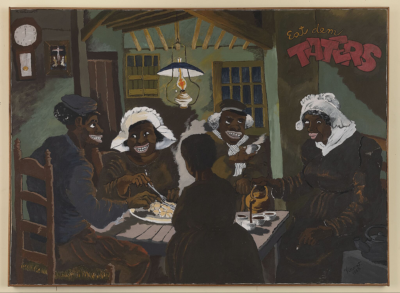
Eat Dem Taters (1975)
(Commentary in parenthesis taken verbatim from the chapter “Robert Colescott: The Untold Story,” by art historian Matthew Weseley, p. 34-5. Weseley analyzes this painting in a clear, keen fashion.) “In 1975, Colescott created two works in which he appropriated well-known nineteenth-century paintings in order to satirize elements of the mythology of blackness that he encountered as a young person. Eat Dem Taters is a spoof of (Vincent) van Gogh’s Potato Eaters, in which Colescott has replaced van Gogh’s somber peasants with exuberantly grinning minstrel figures in order to send up the myth of the “happy darky.” The notion that blacks could be happy with very little was a staple of pre-World War II Hollywood films, and it was also included in school textbooks of the period, in which Blacks were described as fortunate to be enslaved, since slavery removed them from their previous, barbaric circumstances in Africa. Colescott has employed the racist imagery of pre-World War II popular culture in order to satirize a prevalent racist attitude.”
Sound familiar in 2020 America? I’m reminded of a PBS Henry Louis Gates documentary I saw last year of the 50th Anniversary of the American Civil Rights Movement, covering up to the present. In one scene, then President Barack Obama is giving an outdoor speech. Protesters, all white, included a young woman who held up a large white poster board with a drawing of a monkey eating a banana. That’s what she thought of the two-term President of the United States of America, who is as much white as he is Black.
That stereotype goes back to slavery times. If you look back at Eat Dem Taters, the head of the man seated at the left visibly resembles that of a rodent. Get my drift?

Les Demoiselles d’Alabama: Vestidas (1985)
This can be thought of as Robert Colescott’s homage to all Black women, all beautiful, no matter the hue, facial features, or body type. We are charming, strong, assertive creatures.
As we bring our now nocturnal chat to a close, I must say that, as a retired public librarian and lifelong lover of books, I feel this commentary/companion book is a great and worthwhile read for all Blacks in America. I have so much more to say about this book. Buy it! Hopefully, if you live in the vicinity, you’ll be able to join the museum mouse and see the Portland exhibition, which is scheduled to close May 17th.
Then, depending on the whim of the coronavirus, the exhibit will move to its final stop, the Chicago Cultural Center, where it’s scheduled to be exhibited from June 20-September 27, 2020. Lucky Chicagoans!
Finally, my personal truth must come out. After two rounds with this articulate, funny, handsome Black man, whom I initially detested, I find I am quite in love with him! Would that he returns to earth. To me, his new lover. To us all. For now, he sojourns quietly with his God, marvelously painting the nighttime sky. Robert Colescott still has much to teach us. His vivid paintings, and colorful life, are the first lessons we must master.


